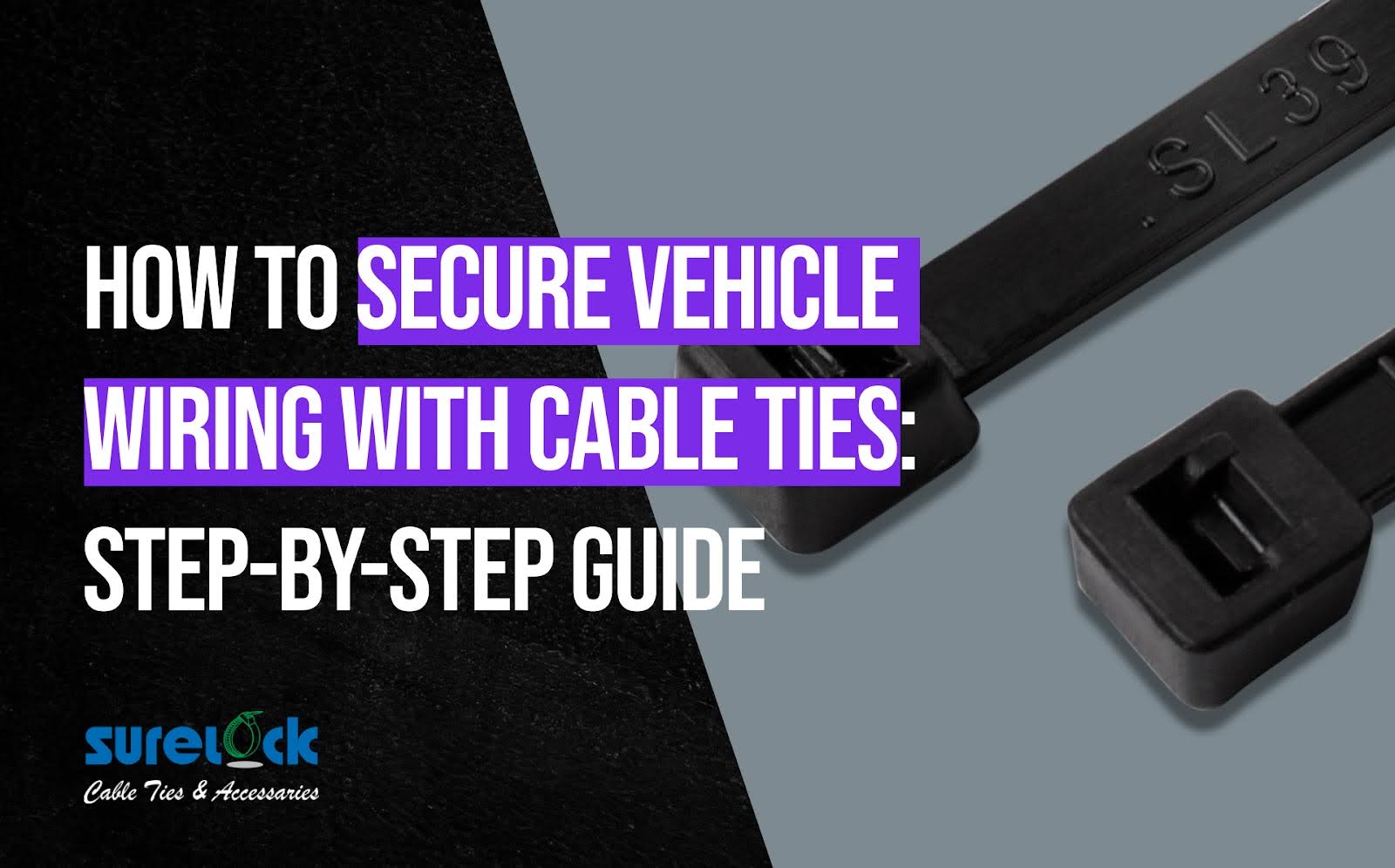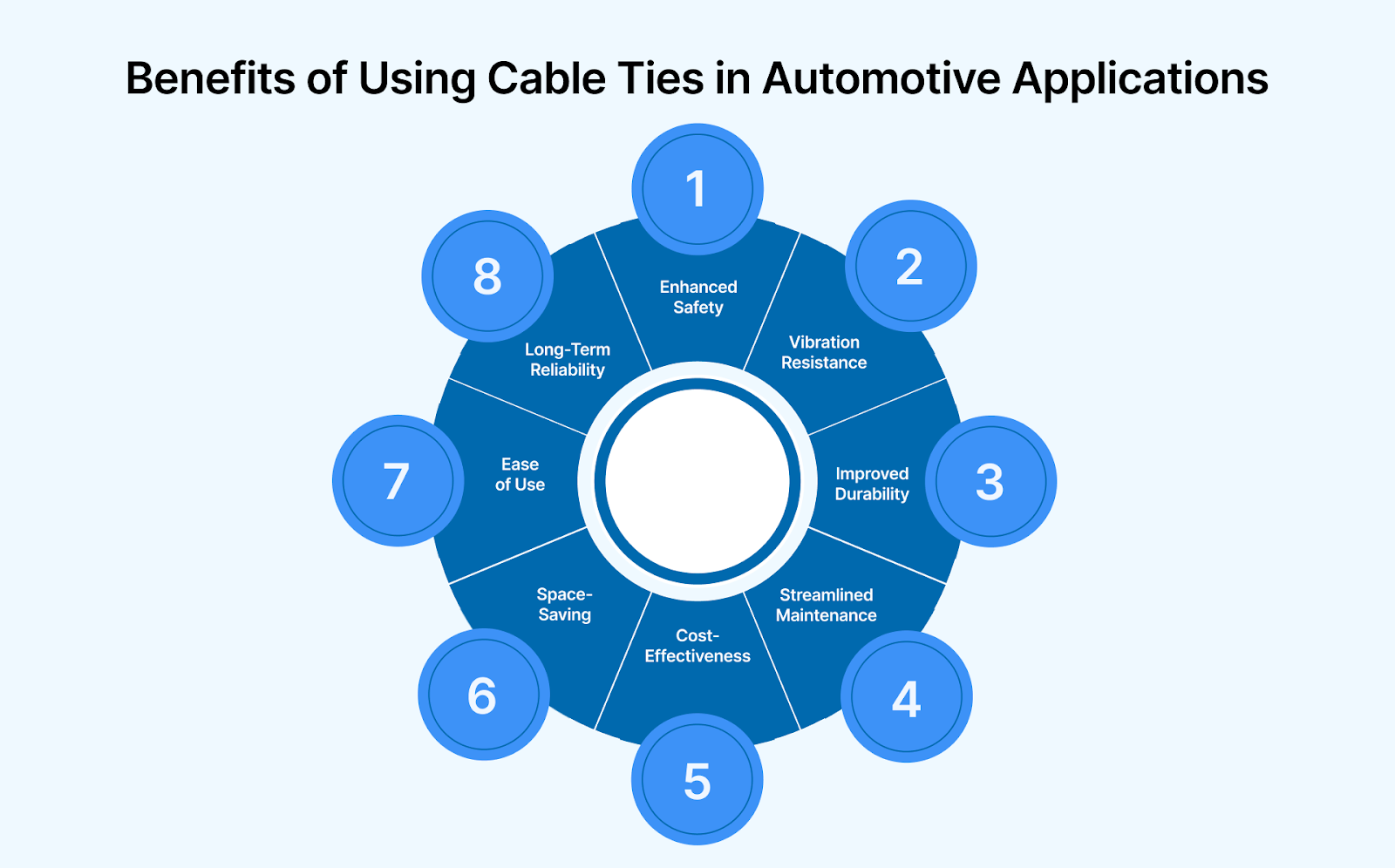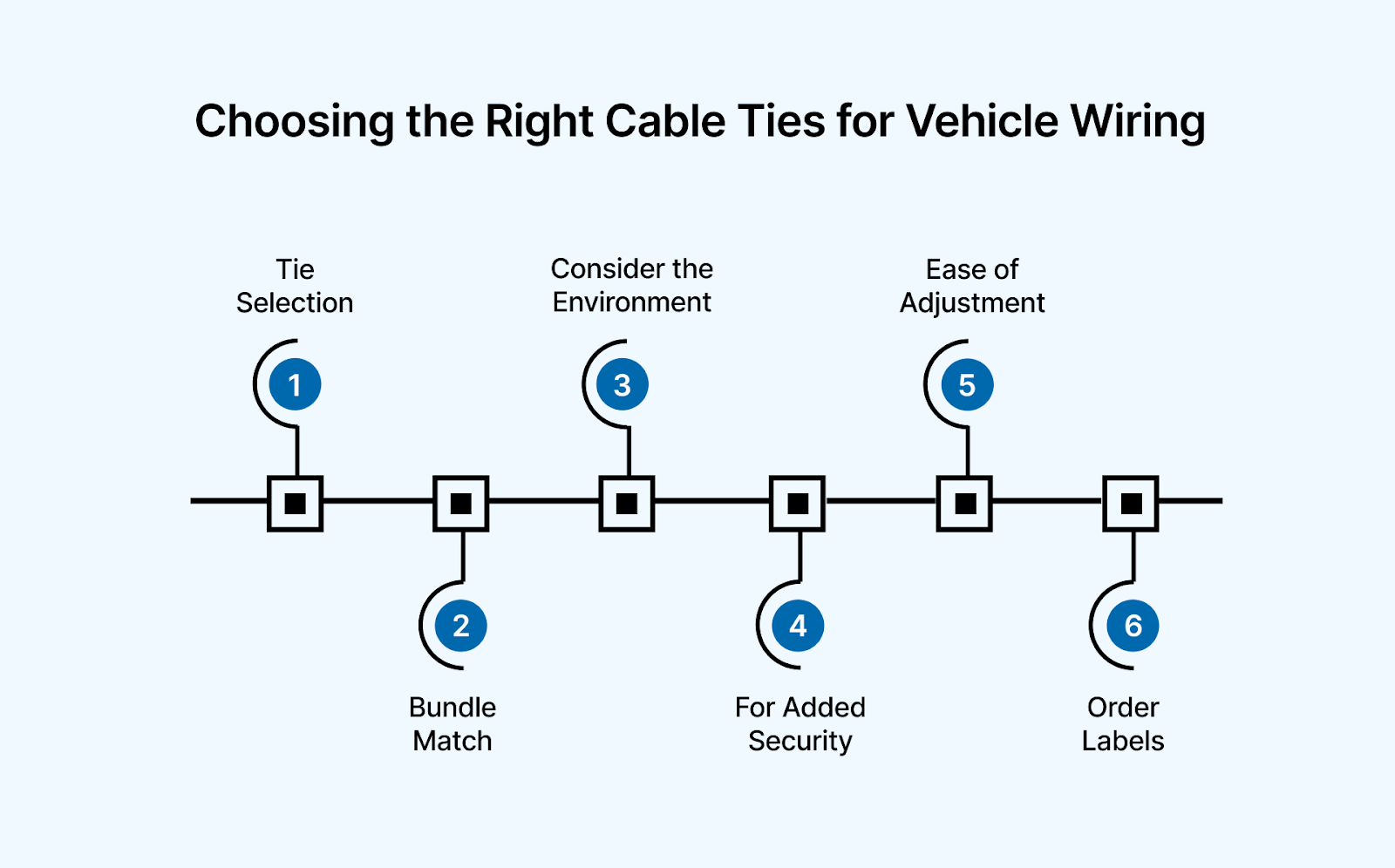How to Secure Vehicle Wiring with Cable Ties: Step-by-Step Guide
July 11, 2025

Is your vehicle's wiring system truly secure, ready to withstand vibrations, heat, and years of wear and tear? For automotive manufacturers and vehicle owners alike, securing vehicle wiring is essential for ensuring safety, reliability, and longevity.
From the assembly line to the open road, wiring harnesses are subjected to extreme conditions. If left unsecured, they can cause dangerous shorts, disrupt essential functions, or even lead to complete system failures. That’s where cable ties come into play.
In this blog, we’ll explore the critical role cable ties play in securing vehicle wiring, their benefits, and how to use them effectively for long-lasting, robust wiring systems. We’ll also discuss best practices and maintenance tips to ensure your vehicle wiring remains safe and functional, no matter the journey.
Why Securing Vehicle Wiring Matters?
In automotive design, securing vehicle wiring is not just a technical necessity—it’s a critical safety measure. Vehicle wiring harnesses are exposed to constant vibrations, extreme temperatures, and various environmental stresses.
If these wires are not properly secured, they can become loose, leading to malfunctions, electrical shorts, or even fire hazards. Ensuring that vehicle wiring is tightly fastened reduces the risk of wear and tear, prevents electrical failures, and ultimately prolongs the life of the vehicle's electrical system.
Secure wiring with cable ties guarantees that every component functions as intended, from critical safety systems to entertainment technology, providing both reliability and peace of mind to vehicle owners.
Now that we recognize the importance of wiring security, let’s highlight the key advantages these ties bring to automotive applications.
Benefits of Using Cable Ties in Automotive Applications

Cable ties, also known as zip ties, are integral components in automotive wiring, offering several distinct advantages. These simple yet efficient fasteners contribute significantly to the vehicle’s performance and longevity. Here’s how they can help:
- Enhanced Safety: By securing wiring, these ties prevent wires from contacting hot surfaces, sharp edges, or moving parts, reducing the risk of electrical shorts, fires, or damage to the wires.
- Vibration Resistance: Vehicles experience constant vibrations from their engines and the movement of the road. Zip ties ensure that wires remain stable and securely fastened, preventing them from loosening or shifting, which could lead to malfunctions or safety issues.
- Improved Durability: With proper installation, these ties can withstand harsh environments like high temperatures and exposure to UV rays. This makes them ideal for use in engine compartments or outdoor environments where wires need long-term protection.
- Streamlined Maintenance: Bundling and organizing wires with zip ties makes maintenance, inspections, and repairs much easier. Neatly secured cables also reduce the chances of tangled or disorganized wiring, which can complicate troubleshooting.
- Cost-Effectiveness: Cable ties are an affordable solution for securing wiring. They reduce the need for expensive alternatives while still delivering superior performance. They also minimize the risk of costly repairs caused by damaged wiring.
- Space-Saving: By bundling cables together neatly, zip ties reduce clutter and free up space within the vehicle, optimizing the design for better airflow and easier access to components.
- Ease of Use: Installation is quick and efficient, whether for a new vehicle design or for repairs. Their user-friendly design ensures that zip ties can be applied in various configurations on production lines or during aftermarket installations.
- Long-Term Reliability: High-quality zip ties, especially those made from UV-resistant or heat-stabilized materials, provide lasting performance even in extreme conditions, ensuring your vehicle's electrical system remains intact throughout its lifespan.
Knowing the different types designed specifically for automotive wiring harnesses is helpful for fully utilizing cable ties.
Types of Cable Ties Used to Secure Vehicle Wiring
Securing vehicle wiring requires specific types of cable ties that can withstand the demanding automotive environment. These ties are designed to ensure that wires stay in place under extreme conditions. Here are the key types of cable ties commonly used in automotive wiring:
- Non-Releasable Cable Ties: These are designed for permanent bundling, ensuring that they cannot be undone once applied. They feature self-locking and one-piece construction, providing fast and easy installation.
- Releasable Cable Ties (Light Duty): These ties can be easily released and reused, making them ideal for wire harnessing where changes are anticipated during development, production, or in the field, as well as for temporary bag packing.
- Releasable Cable Ties (Heavy Duty): These are useful in harnessing where changes are anticipated during development, production, or in the field, and are also used for temporary bag packing. They can be released & reused with a thumb release button.
- Outside Push Mount Tie: Used for mounting bundles to surfaces like vehicle chassis or appliances, this one-piece tie eliminates the need for screws or adhesive mounts. The push mount head fits easily into pre-drilled holes, offering quick and simple installation.
- Inside Push Mount Tie: Ideal for attaching bundles to surfaces, especially in environments with constant vibration, this one-piece design eliminates the need for screws or adhesives. The tie head can be pressed into pre-drilled holes for secure cable mounting.
- Outside Push Mount Tie: Designed for mounting bundles to surfaces like vehicle chassis, these ties can be easily pressed into pre-drilled holes for a secure, vibration-resistant hold.
- Chassis Tie HD & Holder: These ties are primarily used for heavy vehicles in the automotive industry. They feature a two-piece construction and adjustable length for a secure fit.
- Inside Push Mount Releasable Tie—Easy Release: Used for attaching bundles to surfaces such as vehicle chassis or appliances. This tie features a one-piece design that eliminates the need for screws or adhesives.
- Inside Push Mount Releasable Tie—Thumb Release: Ideal for attaching bundles to surfaces, this tie features a thumb release button that opens wire bundles when changes are required. This one-piece design eliminates the need for screws or adhesives, ensuring quick and secure mounting.
- Double Loop Tie: Ideal for tying parallel routing cables, this tie enables the separation of bundles with just one cable. It accommodates various diameters, offering flexibility.
- Double Lock Tie: Ideal for securing and bundling cables in industries like utilities and construction, this tie offers superior tensile strength and features outer serrations to prevent cable damage. The double-locking head ensures a firm, secure grip without slipping.
- Belt Tie: Suitable for low-cost bunching applications, this tie is designed for situations where high tensile strength is not required, offering an economical and efficient solution for harnessing.
- Push-mount fir Tree Ties: Used for securing cable harnesses in industries like automotive, aviation, and panel building. This tie features a fir tree design with a disc that ensures a firm hold and minimizes exposure to dust and water.
- Outside Serration Ties: Ideal for both indoor and outdoor cable bunching, these ties feature outside serrations that minimize surface damage. The self-locking, one-piece construction ensures fast installation and is non-reusable once locked in place.
Surelock offers a comprehensive range of cable ties designed for automotive applications. From heavy-duty to releasable options, our products are engineered to meet the most demanding requirements of vehicle wiring. Discover our full selection of zip ties today.
With types clearly outlined, let’s explore exactly how these zip ties function in practical automotive wiring scenarios.
Uses and Applications of Cable Ties in Vehicle Wiring
Cable ties are designed to provide reliable solutions for holding wires in place, ensuring safety, and streamlining maintenance tasks. Whether it's for securing cables in the engine compartment or organizing wiring in tight spaces, these ties help improve vehicle performance and longevity.
Here are the typical uses and applications of cable ties in vehicle wiring:
- Organizing Wiring Harnesses: Zip ties bundle wires together, preventing tangling and ensuring clean, efficient vehicle wiring systems.
- Securing Cables in the Engine Compartment: High-temperature resistant cable ties secure wires in the engine bay, protecting them from heat exposure and vibrations.
- Preventing Cable Movement: In areas with high vibrations, zip ties help to secure wires and prevent them from shifting, which could lead to short circuits or wire damage.
- Managing Power Cables: They securely hold power cables in place, ensuring a steady electricity supply to critical vehicle systems.
- Mounting Electrical Components: Ties are used to secure components, such as sensors and relays, to prevent movement during vehicle operation.
- Routing Wires Through Panels: This helps guide and hold wires running through vehicle panels securely, eliminating the risk of disconnection or damage.
- Fastening Wires in Tight Spaces: They are ideal for securing wires in small or hard-to-reach spaces, ensuring that no wire is left unsecured or prone to damage.
- Protecting Against Abrasions: Ties protect wiring from friction and damage by holding cables away from sharp edges and surfaces in the vehicle.
- Reducing Wear and Tear: They reduce the risk of wear by keeping wires properly positioned and secured, contributing to longer-lasting wiring systems.
- Improving Aesthetics and Functionality: In some cases, zip ties are used to neatly route wires, contributing to a cleaner and more organized vehicle interior.
These uses highlight the versatility and necessity of zip ties in the automobile industry, ensuring the longevity and efficiency of vehicle wiring systems.
After seeing how these ties are used, choosing the correct ones is essential; let’s identify factors that ensure the right selection.
Choosing the Right Cable Ties for Vehicle Wiring

Selecting the appropriate cable ties for vehicle wiring is crucial to ensure safety, durability, and optimal performance. The right choice depends on factors such as load requirements, material properties, and specific application needs. Here’s how to choose the right ties for automotive wiring:
- Choose the Right Tie for the Application: Select non-releasable cable ties for permanent bundling and secure fastening. For applications requiring flexibility and easy adjustments, use releasable cable ties (light or heavy duty).
- Match the Tie Size to the Bundle: Measure the diameter of the wiring bundle and select a cable tie size that fits snugly, providing sufficient tension without overtightening.
- Consider the Environment: For mounting purposes, use push-mount ties, as they are designed for secure attachment to vehicle wiring harnesses.
- For Added Security: Choose ties that provide a double-locking mechanism in high-vibration areas to ensure extra security and prevent wires from loosening.
- Ease of Adjustment: Select releasable ties for situations where frequent adjustments or removal of wiring are necessary, offering flexibility and ease of use.
- For Labeling and Organization: Use ties designed for tagging to ensure clear identification and organization of wires, facilitating maintenance and system management.
Selecting the correct cable tie is just the beginning; let’s examine how to secure vehicle wiring effectively.
Also read: Cable Ties vs Zip Ties: Key Differences Explained
How to Secure Vehicle Wiring with Cable Ties
Securing vehicle wiring with cable ties is a crucial process to ensure that the electrical systems in vehicles function properly and safely. With vehicle wiring being subjected to vibrations, temperature changes, and movement, proper management is key to preventing damage and ensuring safety. Below are the steps:
1. Organize and Route the Wires
Start by organizing the vehicle's wiring. Lay out the wires according to their function and routing path. Make sure they are grouped logically, as this ensures neatness and easy access for repairs or upgrades. In vehicles, wires are often routed through harnesses and specific channels to minimize movement and protect them from external factors, such as heat and friction.
2. Choose the Appropriate Cable Tie
Always choose the correct cable tie for automotive applications based on the environment. In most cases, non-releasable cable ties are used to secure wiring permanently. Ensure that the size of the cable tie corresponds to the bundle size and that it can handle the weight and tension of the wiring without breaking or slipping.
- Tip: For use in high-vibration areas (such as near the engine or exhaust), opt for heavy-duty cable ties that can withstand vibrations and heat.
3. Position the Cable Tie Correctly
Place the cable tie around the wire bundle. Ensure the tie is positioned at strategic intervals, around every 6-8 inches, depending on the bundle size. Vehicle wiring is often exposed to a lot of movement, so keeping the wiring snugly tied but not overly compressed is crucial.
Be mindful to place ties in locations that avoid areas prone to wear, such as near sharp edges or areas that could cause abrasion to the wires.
4. Tighten the Cable Tie Securely
When tightening the cable tie, it’s essential to avoid over-tightening, as this can damage the wire insulation or even the cable itself. The goal is to create a secure hold without putting unnecessary pressure on the wiring.
Tighten the cable tie firmly, ensuring that the wires remain in place while still allowing for some flexibility to accommodate expansion or movement. Use a tension tool or hand-tighten if necessary.
5. Trim the Excess Tie
Once the cable tie is tightened, use wire cutters or a dedicated tie-cutting tool to trim off the excess length. Leave a small portion of the tie to prevent slippage, but avoid leaving sharp edges that could cause injury or potentially damage surrounding components.
6. Mounting Points for Secure Hold
For additional hold, especially in areas where wires need to stay attached to vehicle panels or other components, use push-mount cable ties. These ties are designed to snap into mounting holes in panels, securing the wires firmly and ensuring they remain in place under stress or vibration.
7. Test the Wiring
After securing all the wiring, conduct a final inspection to ensure that no wire is too tightly secured and that each section is bundled correctly. Check for clearance from heat sources and sharp edges, as both can cause cable degradation over time. Ensure that all ties are secure but still allow for some movement and flexibility where necessary.
By following these steps, you ensure that the wiring in your vehicle remains securely organized and protected from potential damage caused by movement, heat, or environmental factors.
Proper installation is crucial, but maintenance matters, too. Let’s review best practices for ensuring ties remain effective in the long term.
Best Practices for Ensuring Secure Vehicle Wiring with Cable Ties
When it comes to securing vehicle wiring, applying the right techniques ensures durability and prevents future issues. Here are key practices to follow for long-lasting results:
- Position Ties at Regular Intervals: Place ties every 6 to 8 inches along the wiring bundle to evenly distribute tension and prevent any one section from bearing too much strain.
- Avoid Sharp Edges and High-Heat Areas: Ties should not press against sharp edges, as this can damage them. Instead, use heat-resistant ties in areas with high temperatures, such as the engine or exhaust.
- Inspect and Replace Damaged Ties Regularly: Check ties for wear and replace any damaged ones promptly. Damaged ties can lead to unsecured wiring, resulting in malfunctions or safety issues.
Ensure long-lasting vehicle wiring security with Surelock's top-quality cable ties. From easy installation to maximum reliability, our products are designed to protect your wiring system.
Finally, to maintain optimal vehicle performance, let’s discuss when and how zip ties should be checked, maintained, or replaced.
Maintaining and Replacing Cable Ties in Vehicles
Regular maintenance and timely replacement of cable ties are essential to ensure your vehicle’s wiring system remains secure, safe, and fully operational. Automotive environments demand durability, and addressing wear and tear on zip ties early can prevent costly repairs and electrical failures. Let’s explore each in detail:
Maintenance Tips for Cable Ties in Vehicles
To keep your ties functioning properly, regular inspections are key. Here are some quick tips to ensure they remain in good condition:
- Inspect Regularly: Perform routine checks of ties during vehicle servicing. Look for signs of wear, such as cracking, discoloration, or looseness.
- Focus on High-Stress Areas: Pay special attention to areas that are highly exposed to heat or vibrations, such as the engine bay or undercarriage.
- Check for Fraying or Weakness: If ties no longer hold wires securely or show visible damage, it's time to consider replacement.
- Avoid Over-tightening: When installing ties, ensure they are secure but not overly tight, as this can compromise the wires or the tie itself.
Replacing Damaged Ties
When ties start to fail, it’s essential to replace them promptly to prevent damage to the wiring and avoid malfunctions. Here’s how you can do it effectively:
- Remove the Damaged Tie: Use proper tools, such as wire cutters or a cable tie removal tool, to carefully cut the old tie without damaging the surrounding wires.
- Select the Right Replacement Tie: Choose a cable tie suited for the environment, such as heat-resistant options for high-temperature areas or corrosion-resistant ties for exposure to moisture.
- Install a New Tie: Secure the wire bundle firmly with the new tie, ensuring it's snug enough to prevent movement but not tight enough to cause wire compression or damage.
- Carry a Variety: Always have an assortment of zip ties on hand, in different sizes and materials, to address different requirements during repairs.
By performing regular maintenance and replacing zip ties as needed, you can significantly extend the life of your vehicle’s wiring system and avoid costly electrical issues in the future.
Wrapping Up
Securing vehicle wiring with cable ties is essential to maintaining the safety and efficiency of your automotive electrical system. Choosing the right ties, following proper installation techniques, and performing regular maintenance ensures your vehicle’s wiring stands the test of time and environmental stress.
At Surelock, we offer a wide range of automotive-grade cable ties that are specifically engineered to meet the demands of vehicle wiring. From heavy-duty ties to releasable options, our products deliver strength, durability, and reliability for every automotive application.
Contact us today to secure your vehicle wiring with the best in the industry.



